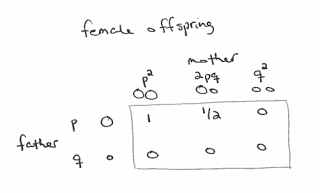Why is my cat orange?
One of the students in my Bayesian statistics class, Mafalda Borges, came up with an excellent new Bayes theorem problem. Here's my paraphrase:
The sex-linked red gene, O, determines whether there will be red variations to fur color. This gene is located on the X chromosome...Males have only one X chromosome, so only have one allele of this gene. O results in orange variations, and o results in non-orange fur.Since females have two X chromosomes, they have two alleles of this gene. OO results in orange toned fur, oo results in non-orange fur, and Oo results in a tortoiseshell cat, in which some parts of the fur are orange variants and others areas non-orange.
If the population genetics for the red gene are in equilibrium, we can use the Hardy-Weinberg principle. If the prevalence of the red allele is p and the prevalence of the non-red allele is q=1-p:
1) The fraction of male cats that are orange is p and the fraction that are non-orange is q.
2) The fractions of female cats that are OO, Oo, and oo are p², 2pq, and q², respectively.
Finally, if we know the genetics of a mating pair, we can compute the probability of each genetic combination in their offspring.
1) If the offspring is male, he got a Y chromosome from his father. Whether he is orange or not depends on which allele he got from his mother:

2) If the offspring is female, her coat depends on both parents:
 That's all the background information you need to solve the problem. I'll post the solution next week.
That's all the background information you need to solve the problem. I'll post the solution next week.

About 3/4 of orange cats are male. If my cat is orange, what is the probability that his mother was orange?To answer this question, you have to know a little about the genes that affect coat color in cats:
The sex-linked red gene, O, determines whether there will be red variations to fur color. This gene is located on the X chromosome...Males have only one X chromosome, so only have one allele of this gene. O results in orange variations, and o results in non-orange fur.Since females have two X chromosomes, they have two alleles of this gene. OO results in orange toned fur, oo results in non-orange fur, and Oo results in a tortoiseshell cat, in which some parts of the fur are orange variants and others areas non-orange.
If the population genetics for the red gene are in equilibrium, we can use the Hardy-Weinberg principle. If the prevalence of the red allele is p and the prevalence of the non-red allele is q=1-p:
1) The fraction of male cats that are orange is p and the fraction that are non-orange is q.
2) The fractions of female cats that are OO, Oo, and oo are p², 2pq, and q², respectively.
Finally, if we know the genetics of a mating pair, we can compute the probability of each genetic combination in their offspring.
1) If the offspring is male, he got a Y chromosome from his father. Whether he is orange or not depends on which allele he got from his mother:

2) If the offspring is female, her coat depends on both parents:
 That's all the background information you need to solve the problem. I'll post the solution next week.
That's all the background information you need to solve the problem. I'll post the solution next week.
Published on October 21, 2016 11:52
No comments have been added yet.
Probably Overthinking It
Probably Overthinking It is a blog about data science, Bayesian Statistics, and occasional other topics.
- Allen B. Downey's profile
- 236 followers



